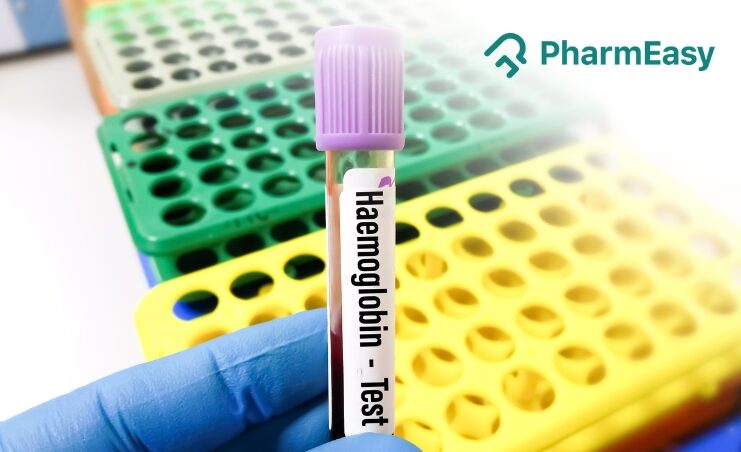Haemoglobin Test, Haematocrit Test and RBC Test: Everything You Need to Know
By Saksham Bhatia +2 more

Get more insightful and
helpful tips to
treat Diabetes for FREE



Download PharmEasy App




Register to Avail the Offer
Send OTPBy continuing, you agree with our Privacy Policy and Terms and Conditions
By Saksham Bhatia +2 more
Haemoglobin test, haematocrit test and red blood cell count test are all part of the complete blood count test. These tests can reveal a lot about your blood and help to diagnose certain health conditions. Let’s understand how they are different from each other and what they help doctors diagnose.

Table of Contents
Haemoglobin is an iron-containing component of the red blood cells or RBCs. Its task is to carry oxygen throughout the body. It is composed of a protein called haeme, which binds with oxygen molecules. Haemoglobin forms an unstable, reversible bond with oxygen. In the oxygenated state, it is called oxyhemoglobin and is bright red in colour. In the reduced state, it looks purplish-blue.
The haemoglobin test measures how much haemoglobin is in the blood and is almost always a part of the complete blood count test or CBC. Doctors want to know your haemoglobin levels if they suspect that you have anaemia. This test becomes necessary when you show signs like-
The normal levels of haemoglobin vary in terms of age and sec. Usually, the values between 13 and 17 g/dL are considered normal. Haemoglobin tests can help with the diagnosis of chronic lung disorder, kidney disease, hormonal imbalances, iron deficiency, bone marrow disease, congenital heart disease (high haemoglobin count), anaemia, certain cancers (low haemoglobin count) and more.
Hematocrit is not the same as haemoglobin test, although both are part of the CBC. While the haemoglobin test measures how much haemoglobin is present in blood, haematocrit measures the percentage of red blood cells in the blood.
Doctors need this test report when they think you may have anaemia, hyponatraemia, kidney disease, leukaemia, thyroid disorder (low haematocrit percentage), dehydration, polycythemia, any cardiovascular disease, obstructive sleep apnoea, carbon monoxide poisoning, scarring of lungs, etc. (high percentage).
The normal range of haematocrit varies according to age, sex and medical history. Usually, the range between 40% and 50% is considered normal.
These ranges may vary from lab to lab.
Always let your doctor interpret the reports instead of doing so yourself.
The red blood cell count is also included in the CBC test. It measures the number of red blood cells or RBCs, in the blood. RBCs contain haemoglobin and the amount of oxygen your cells get is directly related to your RBC count.
The RBC count test report can help a doctor diagnose iron deficiency anaemia, Vitamin B12 deficiency anaemia (low RBC count), anaemia due to blood loss and hemolytic anaemia, dehydration, bone marrow disease, kidney disease, pulmonary fibrosis, erythrocytosis and cardiovascular diseases (high RBC count) and more.
Though dependant on age, sex and medical history, 4.5 – 5.5 x 103 / μL is considered to be the normal range for RBC count.
If your doctor suggests a blood test, it is crucial to show the report to him/her. Many factors influence test reports that non-medical professionals are not aware of. What is the normal range for one person may not be a healthy level for you and vice versa. Self-diagnosis and self-medication will not treat the underlying condition and may usher in new problems. Always follow your doctor’s advice and prescription.
CBC includes many vital tests that shed light on many aspects of your blood health. Get the test done at highly reliable labs and follow the course of action suggested by your doctor.
Click here to book a CBC test.
Disclaimer: The information provided here is for educational/awareness purposes only and is not intended to be a substitute for medical treatment by a healthcare professional and should not be relied upon to diagnose or treat any medical condition. The reader should consult a registered medical practitioner to determine the appropriateness of the information and before consuming any medication. PharmEasy does not provide any guarantee or warranty (express or implied) regarding the accuracy, adequacy, completeness, legality, reliability or usefulness of the information; and disclaims any liability arising thereof.
Links and product recommendations in the information provided here are advertisements of third-party products available on the website. PharmEasy does not make any representation on the accuracy or suitability of such products/services. Advertisements do not influence the editorial decisions or content. The information in this blog is subject to change without notice. The authors and administrators reserve the right to modify, add, or remove content without notification. It is your responsibility to review this disclaimer regularly for any changes.
Ref links

Leave your comment...
Comments